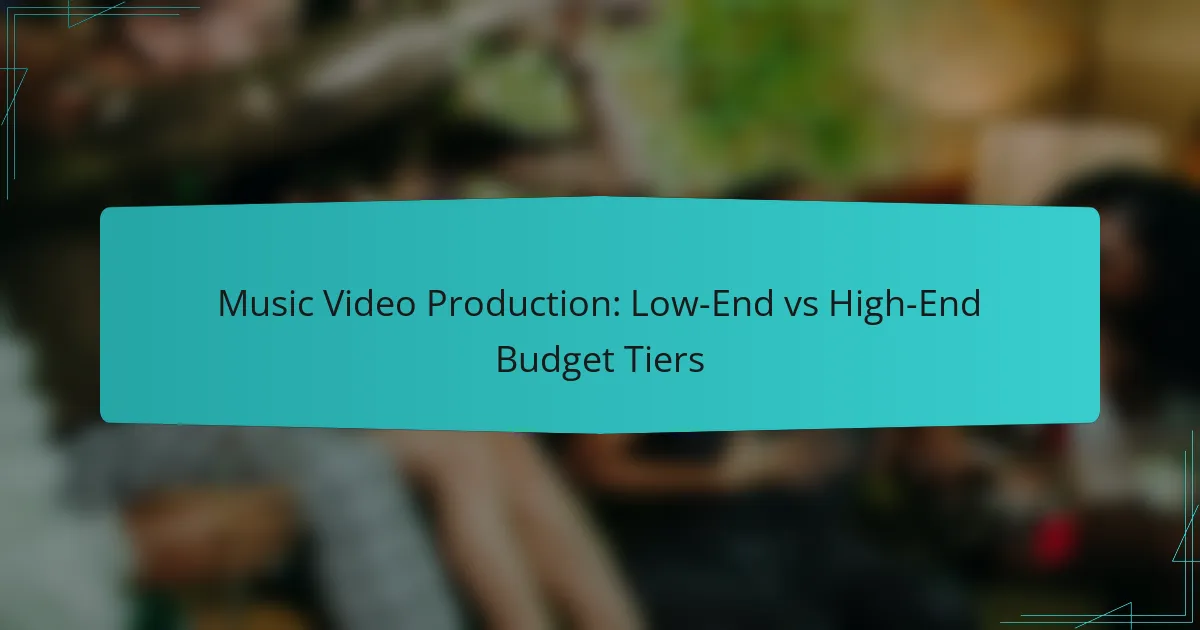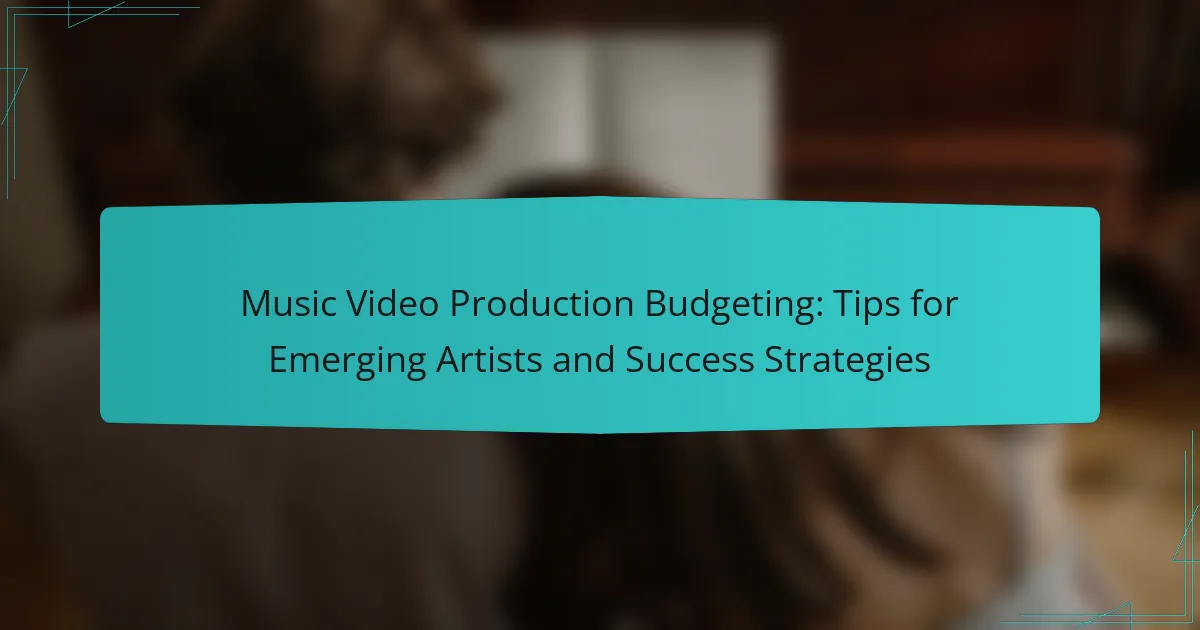Music video production costs for indie artists can vary significantly, influenced by the project’s scope, style, and available resources. Budgets typically range from a few hundred to several thousand dollars, depending on factors such as crew size, location, and equipment. By understanding these elements and planning accordingly, indie artists can effectively manage their budgets and avoid unexpected expenses.

What are the typical music video production costs for indie artists?
Typical music video production costs for indie artists can vary widely based on the project’s scope, style, and resources. Generally, budgets can range from a few hundred to several thousand dollars, depending on factors such as crew size, location, and equipment used.
Average costs for low-budget productions
Low-budget music video productions typically cost between $500 and $2,000. These projects often rely on minimal crew, basic equipment, and simple locations, such as homes or local parks. Indie artists may choose to shoot these videos themselves or collaborate with emerging filmmakers looking to build their portfolios.
Common expenses in this tier include basic camera gear, lighting, and editing software. To save costs, artists can utilize natural lighting and limit the number of shooting days.
Average costs for mid-range productions
Mid-range music video productions generally fall within the $2,000 to $10,000 range. These videos often feature a larger crew, professional equipment, and more elaborate sets or locations. Artists in this category may work with experienced directors and cinematographers to enhance the video’s quality.
In this budget tier, costs may include hiring actors, renting equipment, and securing permits for specific locations. It’s crucial to plan carefully to avoid overspending on unexpected expenses.
Average costs for high-end productions
High-end music video productions can exceed $10,000, with some reaching into the hundreds of thousands. These projects typically involve a full production team, advanced technology, and high-profile locations. Artists aiming for a polished, cinematic look often invest significantly in this tier.
Expenses may include hiring well-known directors, elaborate set designs, and extensive post-production work. To justify the investment, artists should ensure that their music video aligns with their branding and marketing strategy, maximizing its potential impact.
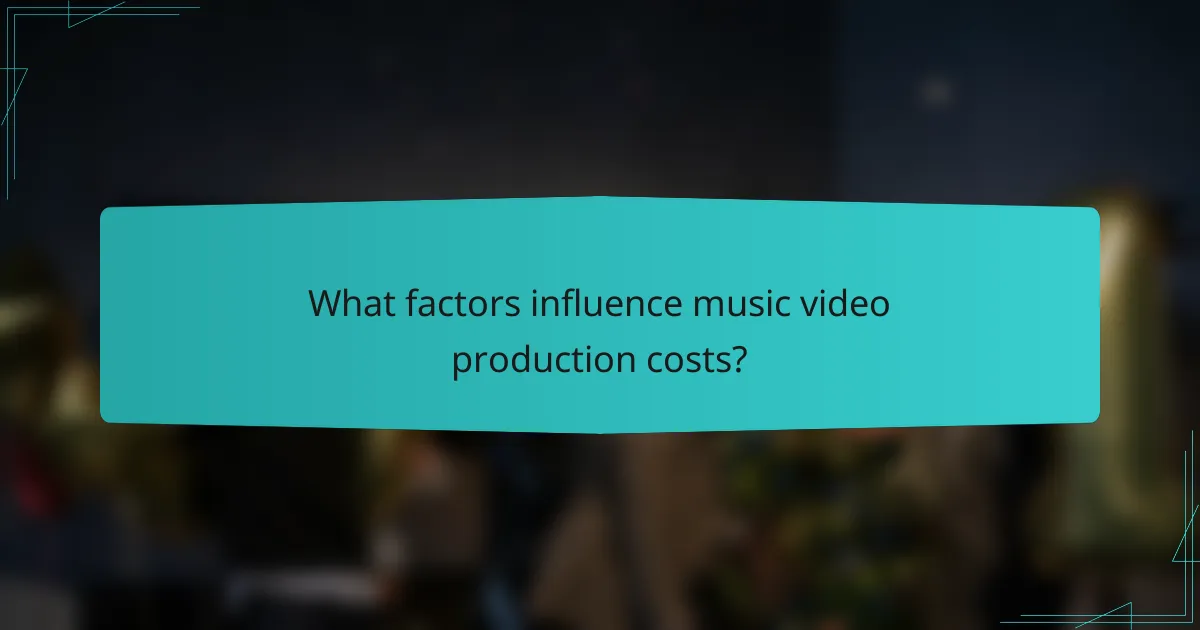
What factors influence music video production costs?
Music video production costs are influenced by various factors including location, cast and crew, and equipment rental. Understanding these elements can help indie artists budget effectively and avoid unexpected expenses.
Location and shooting environment
The location where a music video is filmed significantly impacts production costs. Renting a studio or securing a unique outdoor setting can range from a few hundred to several thousand dollars, depending on the location’s popularity and accessibility.
Additionally, local regulations may require permits, which can add to the overall budget. It’s essential to research potential locations thoroughly and factor in any associated fees to avoid surprises later on.
Cast and crew expenses
Hiring talent and crew members is another major cost in music video production. This includes not just the performers but also directors, cinematographers, and production assistants. Rates can vary widely, with experienced professionals charging higher fees, often in the hundreds or thousands of dollars per day.
Indie artists should consider negotiating rates or collaborating with emerging talent to manage costs effectively. A well-defined budget for cast and crew can help ensure that funds are allocated appropriately without compromising quality.
Equipment rental costs
Equipment rental is a crucial factor that can significantly affect the overall budget. High-quality cameras, lighting, and sound equipment can cost anywhere from a few hundred to several thousand dollars per day to rent. It’s important to assess the specific needs of the video and choose equipment that balances quality with cost.
Consider renting from local suppliers to save on shipping costs and ensure availability. Additionally, some production companies offer package deals that can provide substantial savings for indie artists looking to keep expenses manageable.
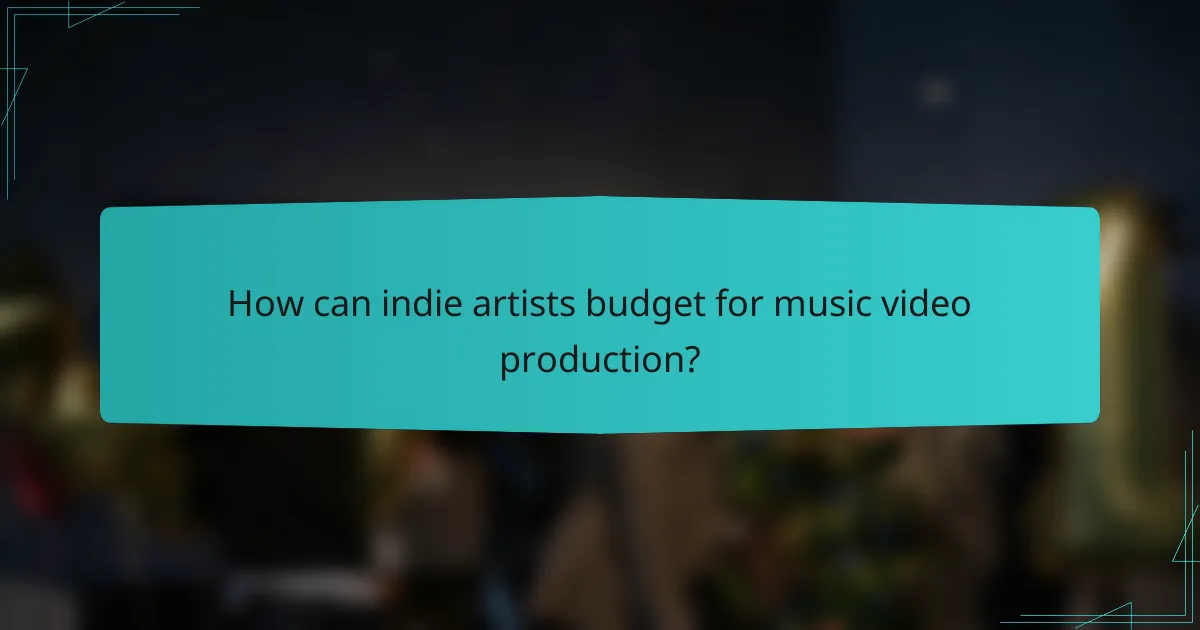
How can indie artists budget for music video production?
Indie artists can effectively budget for music video production by carefully planning their expenses and prioritizing key elements. Understanding the various cost tiers and potential hidden expenses will help ensure that the final product aligns with their artistic vision while remaining financially feasible.
Creating a detailed budget plan
Start by outlining all potential costs associated with the music video, including pre-production, production, and post-production expenses. Common budget items include location fees, equipment rental, crew salaries, and editing costs. A detailed budget plan should categorize these expenses to provide a clear overview of where funds are allocated.
Consider using a spreadsheet to track these costs, allowing for easy adjustments as needed. Aim for a budget range that reflects your resources; for indie projects, this could be anywhere from a few hundred to several thousand USD, depending on the complexity of the video.
Allocating funds for unexpected expenses
It’s crucial to set aside a portion of your budget for unforeseen costs that may arise during production. A common practice is to allocate around 10-20% of your total budget for these unexpected expenses. This buffer can cover last-minute changes, additional crew members, or equipment failures.
Regularly review your budget throughout the production process to ensure that you remain within your limits. Keeping a close eye on spending can help you avoid financial strain and allow for necessary adjustments without compromising the quality of the video.
Using cost-effective production techniques
Indie artists can utilize various cost-effective production techniques to maximize their budget. For instance, shooting in natural light can reduce the need for expensive lighting equipment, while using a smartphone or a DSLR camera can significantly lower equipment costs. Collaborating with local filmmakers or students can also provide quality production at a lower price.
Consider leveraging online platforms for editing and post-production services, which often offer competitive rates compared to traditional studios. Additionally, creative storytelling and unique concepts can make a video stand out without requiring a large budget, allowing indie artists to achieve professional results while staying financially responsible.
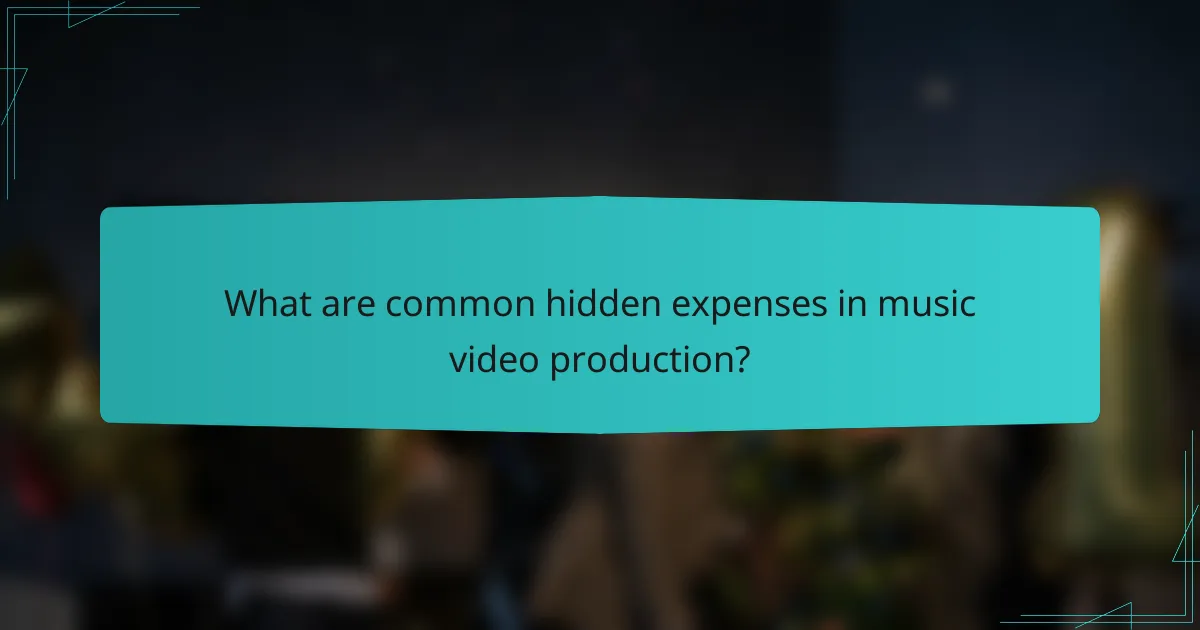
What are common hidden expenses in music video production?
Hidden expenses in music video production can significantly impact your budget. These costs often arise unexpectedly and can include various elements that are not immediately apparent during the planning phase.
Post-production costs
Post-production costs encompass editing, color correction, sound design, and visual effects. These expenses can vary widely, often ranging from a few hundred to several thousand dollars, depending on the complexity of the video and the expertise of the professionals involved.
It’s crucial to allocate a portion of your budget specifically for post-production. Many indie artists underestimate these costs, leading to financial strain later in the project. Consider getting quotes from multiple editors to find a balance between quality and affordability.
Licensing fees for music and locations
Licensing fees for music and locations can add significant costs to your music video budget. If you plan to use copyrighted music, you will need to secure the appropriate licenses, which can range from a few hundred to thousands of dollars, depending on the artist and the intended use.
Location fees can also vary greatly. Public spaces may require permits, while private venues often charge rental fees. Always research and factor these potential costs into your initial budget to avoid surprises.
Marketing and distribution expenses
Marketing and distribution expenses are essential for ensuring your music video reaches its intended audience. Costs can include social media promotions, advertising, and distribution platform fees, which can collectively add up to several hundred or thousands of dollars.
To maximize your budget, consider creating a marketing plan that outlines your target audience and the most effective channels for reaching them. Utilize free or low-cost platforms where possible, and set aside funds specifically for promotional activities to enhance visibility and engagement.

How do music video production costs vary by region?
Music video production costs can differ significantly based on the region due to factors like local labor rates, equipment availability, and market demand. Understanding these variations helps indie artists budget effectively for their projects.
Production costs in major US cities
In major US cities like Los Angeles, New York, and Atlanta, music video production costs typically range from $5,000 to over $100,000. High-end productions often require elaborate sets, professional crews, and extensive post-production work, driving up expenses.
Indie artists should consider the cost of hiring local talent and renting equipment, which can vary widely. For example, a basic shoot in Los Angeles might start around $10,000, while a more complex project could easily exceed $50,000.
Production costs in European markets
European markets present a diverse range of production costs, influenced by the country and city. In cities like London and Berlin, budgets can range from €3,000 to €80,000, depending on the scope and complexity of the video.
Artists should be aware of additional expenses such as location permits and union regulations, particularly in the UK. Collaborating with local production companies can help navigate these costs effectively.
Production costs in emerging markets
Emerging markets, such as those in Southeast Asia and Eastern Europe, often offer lower production costs, typically ranging from $1,000 to $20,000. This affordability can be appealing for indie artists looking to maximize their budget.
However, it’s essential to consider potential trade-offs, such as varying levels of production quality and access to advanced technology. Engaging local talent can help mitigate these issues while keeping costs manageable.
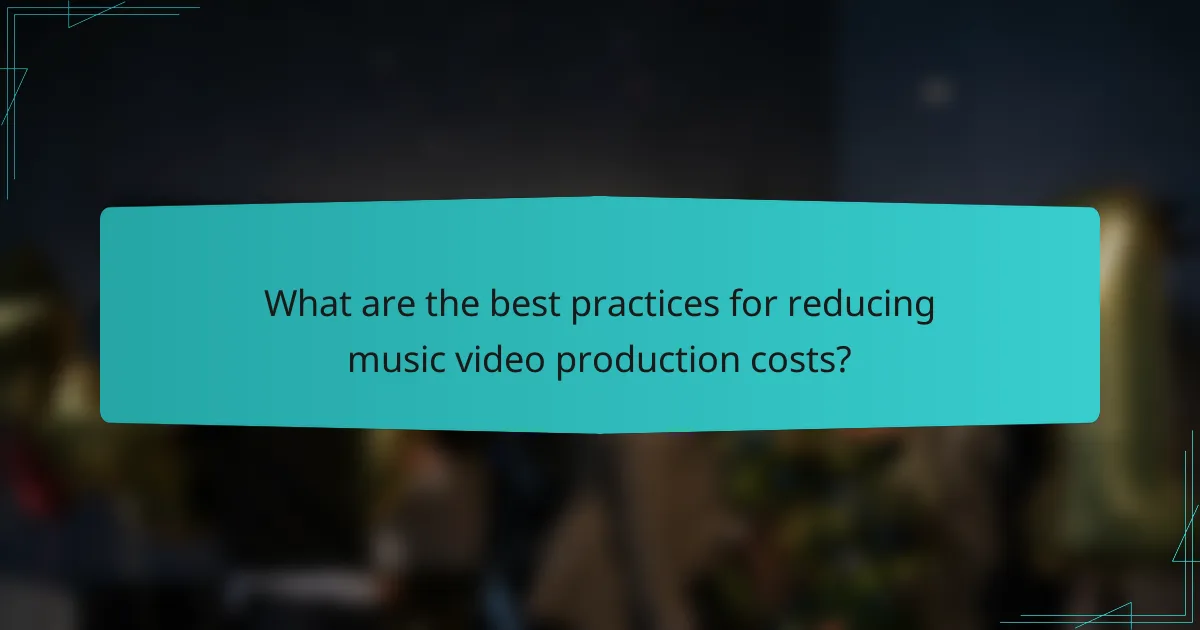
What are the best practices for reducing music video production costs?
To reduce music video production costs, focus on strategic planning, resource management, and collaboration. Implementing cost-effective practices can significantly lower expenses while maintaining quality.
Utilizing local talent and resources
Hiring local talent, including videographers, actors, and crew members, can drastically cut travel and accommodation costs. Local professionals often have a good understanding of the area, which can enhance the video’s authenticity.
Additionally, using local venues or community spaces instead of expensive studios can save money. Look for partnerships with local businesses that may offer their facilities in exchange for promotion or exposure.
Leveraging crowdfunding platforms
Crowdfunding platforms like Kickstarter or Indiegogo can be effective for raising funds specifically for music video projects. By presenting a compelling pitch, indie artists can attract contributions from fans and supporters.
Set clear funding goals and offer enticing rewards, such as exclusive content or merchandise, to encourage backers. This approach not only helps finance the video but also builds a community around the project.
Collaborating with other artists
Collaborating with other artists can lead to shared resources and reduced costs. By pooling talent and equipment, you can create a higher-quality video without the burden of full expenses.
Consider joint projects where both artists benefit from the exposure and shared audience. This can include cross-promotional efforts, which can amplify reach while minimizing individual costs.

